
Los Alamos
The Manhattan Project and the Early Cold War at Los Alamos
The mesa where Los Alamos, New Mexico,
is now located was first inhabited around 900–1150 CE
by Keres-speaking natives.
Other native groups lived here
during the immediately following centuries.
In the late 1800s many Hispanic and Anglo people
made homesteading claims,
building cabins where they lived during the warmer months
to raise livestock.
In 1917 a school for boys from moderately wealthy families
was founded.
It combined college preparatory studies
with Boy Scout activities.
Then, in 1943, the U.S. Department of War seized the land.
It became Site Y or Project Y,
the research and development home of the
Manhattan Project
which developed the world's first nuclear weapons.
Over 6,000 scientists and technical personnel worked here
through the end of World War II.
Major General Leslie Groves
directed the overall project
for the U.S. Army's Corps of Engineers.
Nuclear physicist J. Robert Oppenheimer
directed the Los Alamos Laboratory that
designed and built the bombs.
Several staff members won the Nobel Prize before or after
their work here during the Manhattan Project.
Advanced astrophysics and, yes, nuclear weapons work
continue here at what's now
Los Alamos National Laboratory
or LANL for short.
Getting There
Take U.S. 84 to the northwest out of Santa Fe to Pojoaque, then turn onto New Mexico Highway 502 and continue to Los Alamos. NM 502 climbs up onto the volcanic Pajarito Plateau, part of the Jemez Mountains. You'll be gaining about 1,700 feet or 520 meters of elevation.
The Bandelier Tuff is thick layers of volcanic ash laid down in a pair of gigantic explosive eruptions from the Valles Caldera, which the next page shows. The eruptions happened about 1.6 and 1.2 million years ago. Layers of basalt, frozen lava, are above and below the compacted ash layers. Basalt is a fine-grained rock formed from low-viscosity lava. It is extremely hard and it protects the soft tuff from erosion. That forms mesas, distinctive flat-topped high areas with steeply sloping sides. My visits to Iceland and Morocco had already made me an aficionado of basalt and tuff layers. The below picture is from where I paused just before reaching Los Alamos, looking back toward Santa Fe at the base of the distant mountains.


Looking west, in the direction of travel, the town of Los Alamos becomes visible on the mesa top.
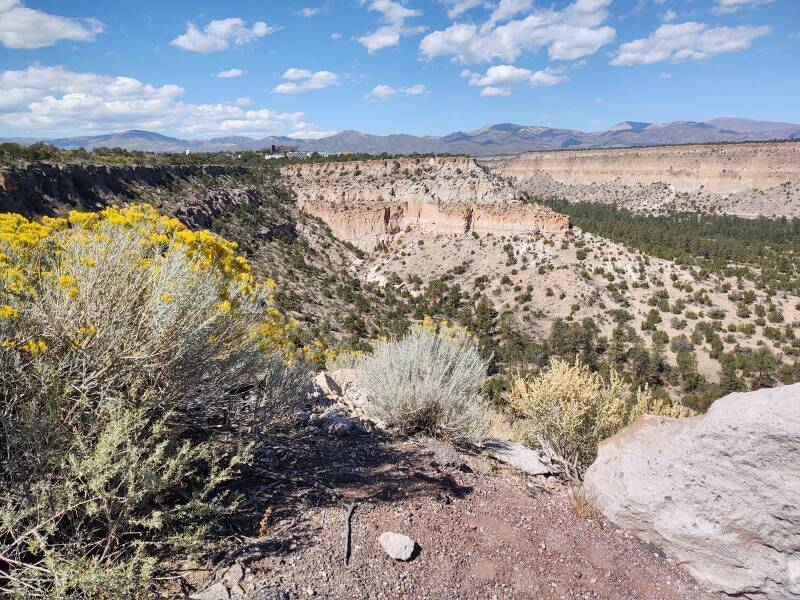
The outer gates and guard towers were removed in 1957. A gate house has been moved to the side, out of the middle of the access road. There are maps and other information inside, and bathrooms.

The Earliest Inhabitants
The site seen below became home to a group of Tewa-speaking people around 1225 CE. Now the town of Los Alamos has been built up around it and the Los Alamos History Museum immediately surrounds it. Two of the scientists' houses we'll see are just beyond the orange tree. The people may have come from Mesa Verde or Chaco Canyon, to the northwest and west, respectively. The pueblo you see here housed two or three families who built the structure out of blocks cut from the compacted volcanic ash tuff. They had bedrooms, kitchens, storage rooms, and a semi-circular kiva used for ceremonies and meetings.
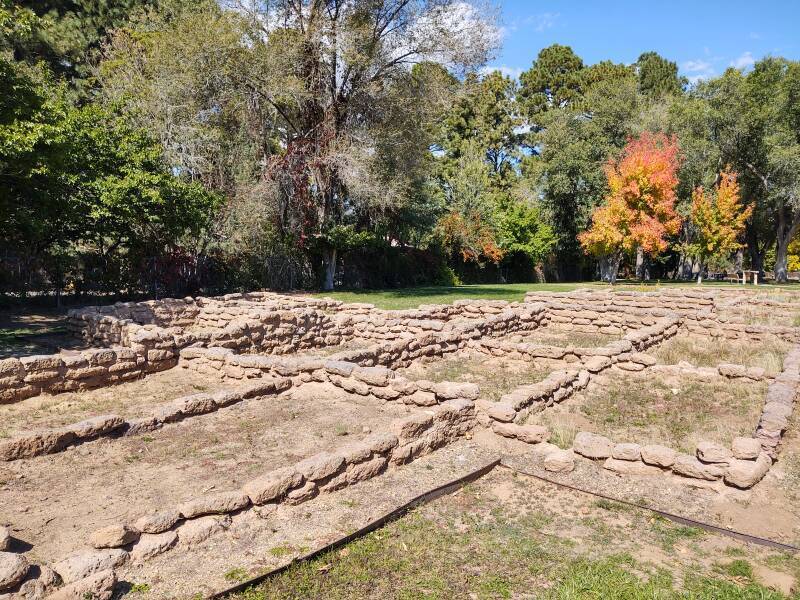
The Ancestral Puebloans left the high Pajarito Plateau by 1500 due to increasing population, decreasing numbers of game animals, raids by the Navajo and Apache peoples, drought, and depleted soil.
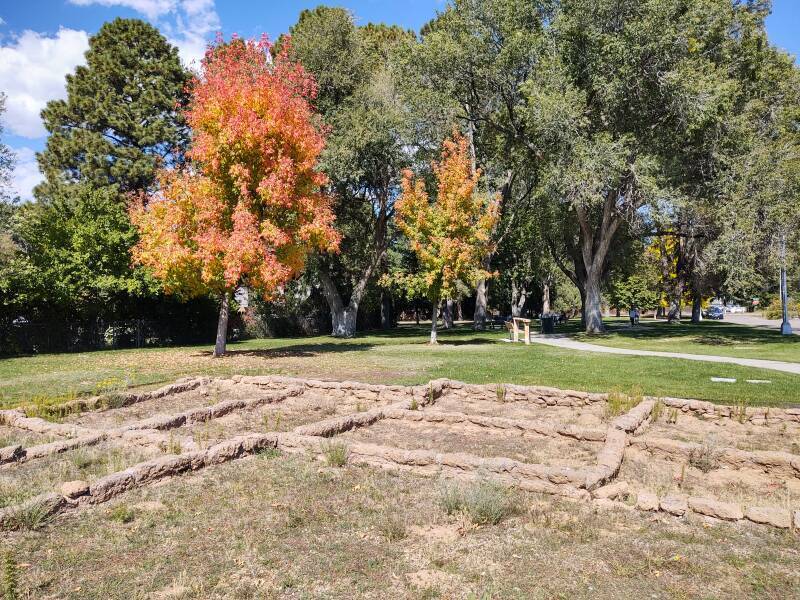
Anglo and Hispanic settlers began applying to the U.S. Government for homestead grants in the late 1800s.
Victor Romero applied in 1913 for a 15-acre plot of land that now is within the boundaries of the Los Alamos National Laboratory. He built the below one-room cabin to house himself, his wife, and their six children.
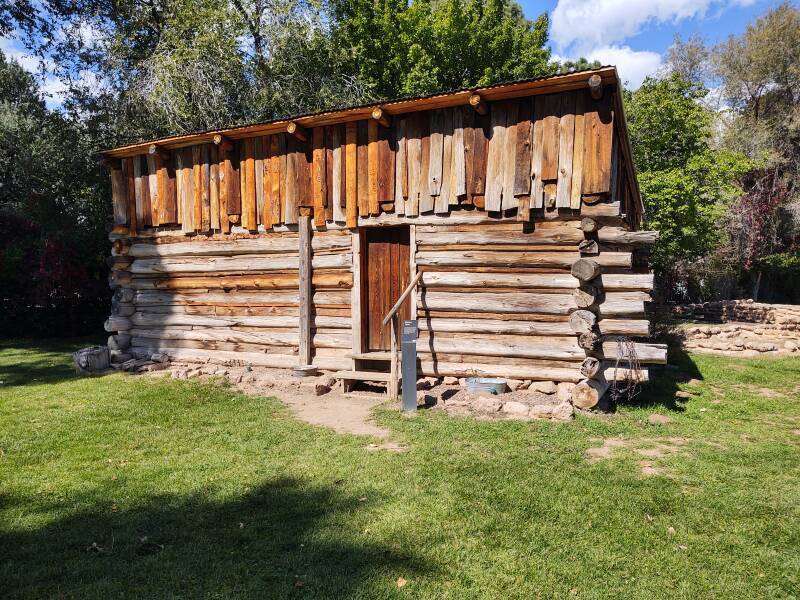
The Romeros lived in this cabin during the crop-growing and livestock-raising seasons, and returned to their home in the Rio Grande Valley for the winters.
Some time before 1938, the Romero family stopped spending their summers on the mesa, but continued to use the fields as pasture for livestock.
In 1943, the federal government seized the Romero family home as part of the Manhattan Project. In 1985, Laboratory historic preservation specialists moved the cabin from its original location to this site in town, where the public can see it. Most of the remaining homesteading properties were destroyed in the Cerro Grande Fire of May 2000.
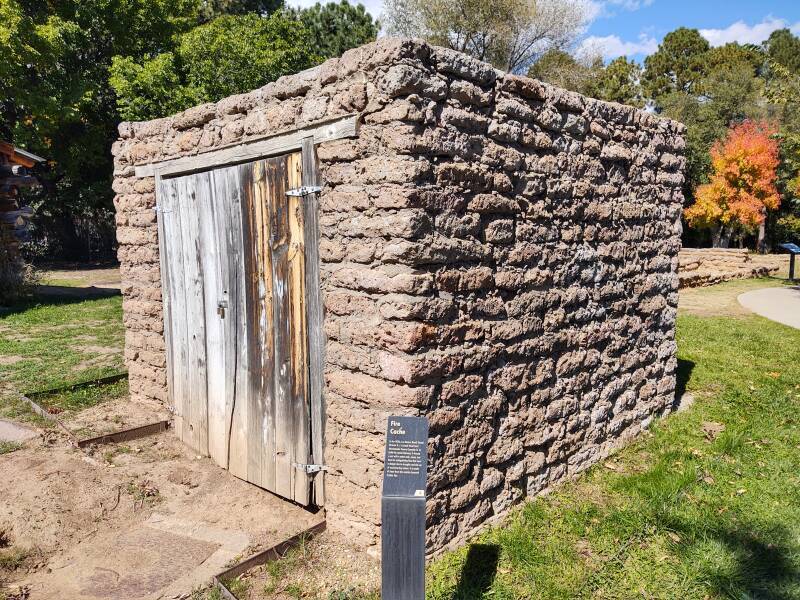
Tuberculosis and the "Lungers"
Visiting the Asclepeion, the Ancient Greek Medical SchoolTuberculosis, once called consumption and now often referred to as TB, is a bacterial disease that usually affects the lungs. Human skeletal remains going back to 9000 BCE show signs of it. Hippocrates described it around 460 BCE as φθισις or phthisis. A vaccine has been available since 1921, and antibiotics are now available to kill the bacteria. But in the early 1900s, various "clean air" sanitoria were all the rage because that's all there was.
John Croghan, a physician, owned Mammoth Cave in Kentucky. He brought 15 tuberculosis patients into his cave in late 1842. He hoped that the constant temperature and clean air in the cave would cure them. Within less than three months, two patients had died and the rest had left. Those who left all died within three days to three weeks of leaving the cave, and Dr Croghan died of tuberculosis six years later.
Subterranean sanctuaries had failed, so other physicians speculated that high altitudes and lowered air pressure were needed. New Mexico and Arizona, with high altitude terrain and dry climates, became popular destination for tuberculosis patients. The settlement of Los Alamos is at about 7,300 feet or 2,230 meters above sea level. "Lungers", as TB patients were often called, would be among the few people making their way to the tiny mesa-top settlement.
The Ranch School
Detroit businessman Ashley Pond had suffered from bronchitis and other ailments as a child. Then he had contracted typhoid fever while serving as a member of Theodore Roosevelt's Rough Riders, an all-volunteer unit in the Spanish-American War. In 1900 he moved to New Mexico for his health. Pond purchased the H. H. Brook homestead on a high plateau near Santa Fe, named the "Los Alamos Ranch" for the cottonwood trees found there.
In 1917 Pond established the Los Alamos Ranch School. It combined a college preparatory curriculum with a highly active outdoor life based on the Boy Scouts of America and motivated by Roosevelt's embrace of "the vigorous life". The students wore Boy Scout uniforms including short pants year round, and always slept on screened porches when they weren't camping in tents on a expedition. Its enrollment of boys aged 12–18 never exceeded 46.
Pond left within the year to serve as an ambulance driver for the American Red Cross in World War I. He left the school under the direction of a similarly minded National Forest ranger and an academic headmaster.
The school marketed itself to moderately wealthy families, and many of the boys went on to prominent careers. They included the writers William S. Burroughs and Gore Vidal; Sears and Roebuck president and general counsel Arthur and Robert Wood; American Motors Corporation president Roy Chapin; and Bill Veeck, who owned three different Major League baseball teams.
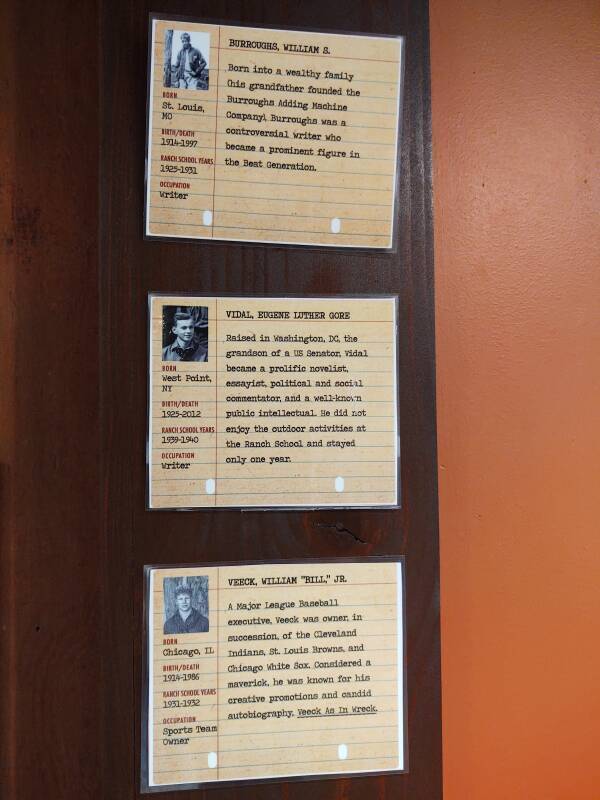
The Fuller Lodge, seen below, was built in 1928. It was built by a Santa Fe architect who, along with the school's director, personally selected the 771 massive pine and aspen trees used in the vertical-log structure. The hanging lanterns inside were designed by a prominent wood-cutting artist.
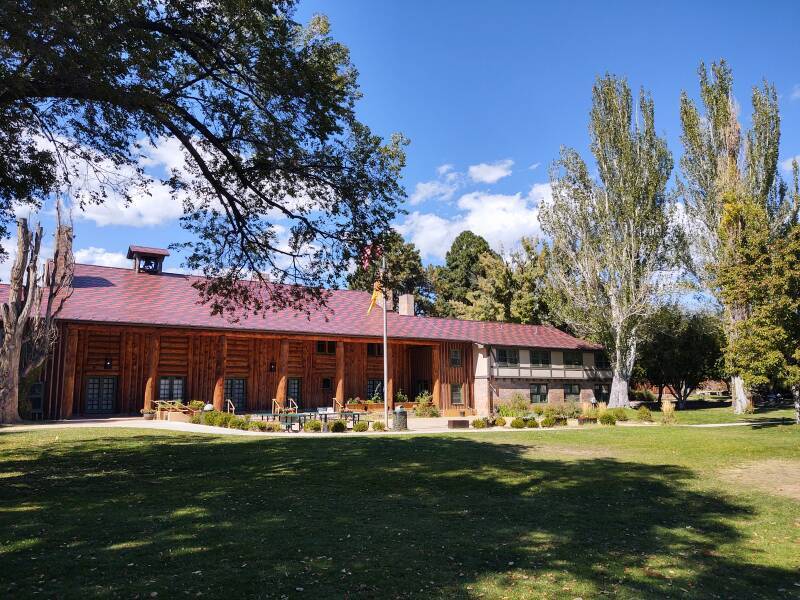
The Lodge housed the school's two-story dining hall and kitchen, the school's infirmary, and residential rooms for staff, guests, and the school's nurse.
In December 7, 1942, exactly one year after the Japanese attack on Pearl Harbor, the federal government informed the school that it was seizing the school and a large surrounding area. Los Alamos was becoming Site Y or Project Y, the research and development home of the Manhattan Project. The Lodge was managed as a hotel during the Manhattan Project years by the U.S. Army Corps of Engineers. It served as the post cafeteria and lodging for senior scientific staff and visiting dignitaries.
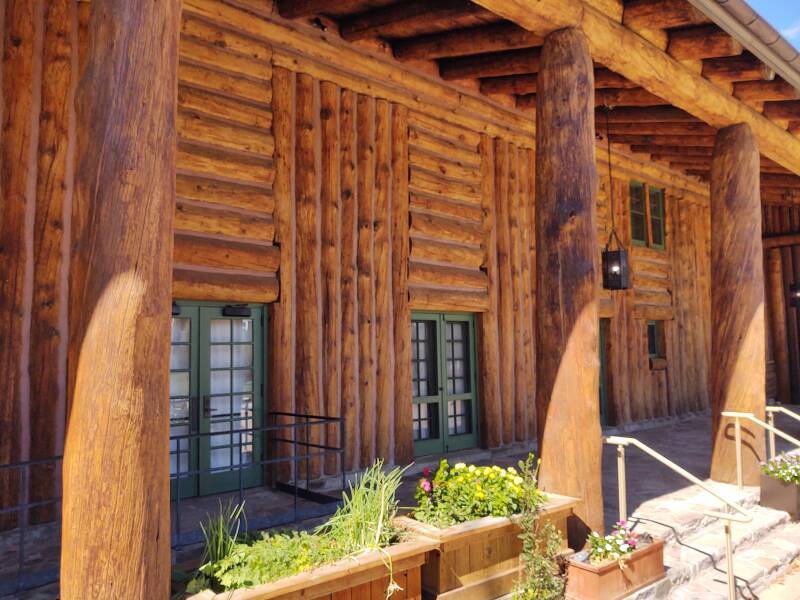
The History Museum, seen below, is the oldest continually occupied building in the town. It was built as an infirmary for the Ranch School in 1918, and then became guest lodging after the Fuller Lodge was built in 1928.
During the Manhattan Project years it continued as guest quarters. General Groves' office and home were in Washington D.C., this was his residence at Los Alamos.
Now it's a museum and book shop. Buy a ticket here for the museum, and use it to also visit some of the surrounding sites.
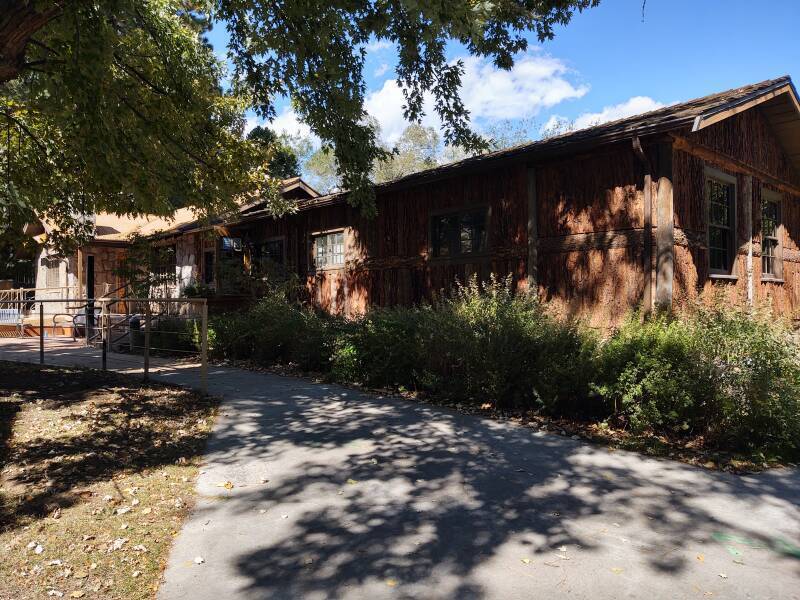
Hans Bethe House
A row of homes had been built to house faculty and some classes for the Los Alamos Ranch School. The buildings constructed for the Manhattan Project were only intended to last through the end of the war. They tended to be rough and primitive.
This row of faculty homes was luxurious by comparison. Other than one newly constructed women's dormitory, these structures had the only bathtubs in town. So, they became known as "Bathtub Row". J. Robert Oppenheimer lived in one, and other elite scientists in others.
The house seen below was built in 1931 as a residence for the Ranch School's business manager, Fred Rousseau, and his wife Edna, a public school teacher. During and immediately after the Manhattan Project it was home to the Nobel-Prize-winning chemist-physicist Edwin McMillan and his wife Elsie from 1942 to 1945. Then Nobel-Prize-winning physicist Hans Bethe and his wife Rose lived here from 1945 to 1946. Max and Viola Roy lived here 1946–1992, and then Richard Morse 1992–2012. Max Roy did a Ph.D. on heavy water, and became director of the Explosives Division at Los Alamos National Laboratory, or LANL, in 1946. Morse was a physicist at LANL.
Despite the Bethes' short time here, it's now called the Hans Bethe House.
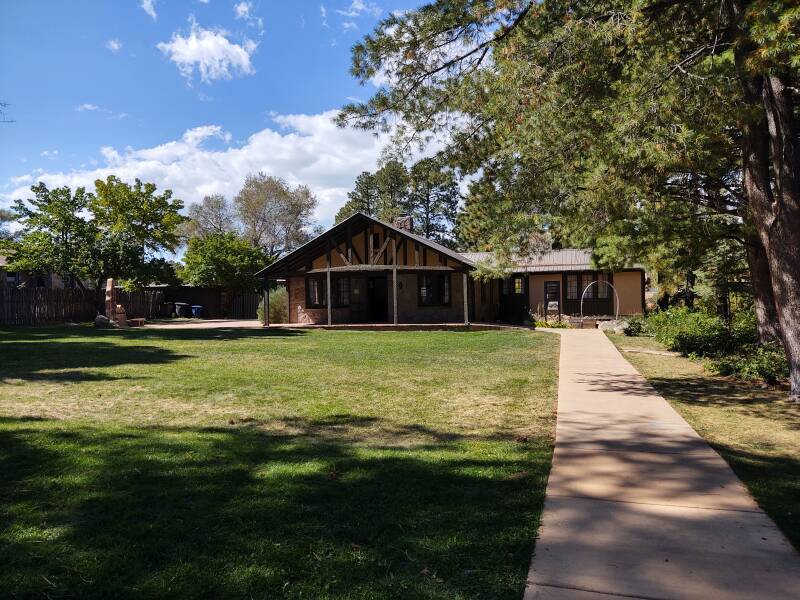
The houses of "Bathtub Row" had been built back in the Ranch School days, and then were occupied by nuclear weapons scientists into the 2010s. So, what you see today is the result of seventy years of additions and renovations. The original house is the section behind the peaked roof over the porch. The lower section that's approximately the right half as seen here was added after World War II. It contains an additional bedroom and full bath.
Neptunium, for example, has atomic number 93
because it has 93 protons and 93 electrons.
Its atomic weight or, to be modern,
relative atomic mass,
is based on its average number of protons plus neutrons.
Varying neutron counts correspond to various isotopes.
So, since:
93 + 146 = 239
Neptunium-239 or 239Np
has 93 protons plus 146 neutrons.
Edwin McMillan earned a doctorate from Princeton University in 1933. In 1940 he co-authored the paper "Radioactive Element 93" describing how they had bombarded uranium-238 with neutrons and created a new element with atomic number 93, which they called neptunium. 239Np then decays to 239Pu, plutonium, another radioactive transuranium element. In 1951 he shared the Nobel Prize in Chemistry with Glenn Seaborg for their discoveries of neptunium and plutonium.
McMillan left Berkeley in November 1940, soon after isolating neptunium, to work at the MIT Radiation Laboratory. He was involved in designing and testing airborne microwave radar.
In August 1941 McMillan moved to the Navy Radio and Sound Laboratory near San Diego. There, he worked on a project to apply some radar concepts to sonar. In September 1942, Oppenheimer recruited him to join the Manhattan Project. McMillan came to be the director of the project to design, test, and build the gun-type device known as Little Boy.

Edwin McMillan's Los Alamos ID badge.

Hans Bethe's Los Alamos ID badge.
Hans Bethe was born in Strasbourg when it was part of Germany. and did a Ph.D. at the University of Munich. He did postdoctoral work at the University of Cambridge. In 1935 he went to Cornell University in Ithaca, New York. Once he became a naturalized U.S. citizen in 1941, he joined the MIT Radiation Laboratory and developed a microwave directional coupler. Then he joined the Manhattan Project in 1942.
At Los Alamos, Oppenheimer appointed Bethe to be the director of the T (or Theoretical) Division, where he worked on calculating the critical mass of uranium-235 and working out the hydrodynamics of implosions.
Practitioners have always used nuclear to describe a pure fission device, and thermonuclear for a device with a stage involving fusion. "Atomic bomb", "A-bomb", "Hydrogen bomb", and "H-bomb" were inventions of the media.
After the war, Bethe worked on the design of the proposed thermonuclear device. He had argued against its development, but joined the project after Truman called for it. He was opposed to the development of the much more powerful warhead, and hoped that his work would show that it was impossible, or at least impractical. However, it worked. He made large contributions to what came to be called the Teller-Ulam design.
Afterwards, Bethe returned to Cornell. He continued to work in theoretical astrophysics into his late nineties, publishing at least one paper every decade through a career of nearly seventy years. He was awarded the 1967 Nobel Prize in Physics for work on stellar nucleosynthesis. In the 1990s he became involved in the gravity wave research into merging neutron stars and black holes.
There's a small room that might have still been the bedroom when the Bethes lived there. It became a study and now contains Hans' desk and some study materials. Those may have been in the main room when they lived here. Now it also contains a display of two nuclear devices.

B52-2 man-portable Special Atomic Demolition Munition,
fielded from the 1960s to 1989.
It's a 239Pu implosion fission device
with a yield of 10–1,000 tons of TNT,
42–4,184 GJ.
FM 5-26 — EMPLOYMENT OF
ATOMIC DEMOLITION MUNITIONS (ADM)

W80 thermonuclear warhead used in all nuclear-armed cruise missiles in the U.S. inventory. Selectable yield of 5 or 150 kT, 21 or 628 TJ.
The man-portable barrel-shaped device above is another B52-2 like what I saw at the museum. It's a nuclear device, purely fission based.
The somewhat bottle-shaped silvery W80 is thermonuclear, in which a fission device explodes first, greating a burst of X-ray and other radiation that compresses and ignites a fusion-based second stage.
Staged thermonuclear devices are generally of the Teller-Ulam design on which Bethe also worked, in hopes that he could help to prove that it was unworkable. Smaller packages like the W80 are shaped somewhat like a peanut shell to better direct the radiation flow from primary to secondary. The spherical or ellipsoidal primary fission element is in the rounded nose, and the secondary fusion stage with its 239Pu "sparkplug" within lithium-deuteride is in the more barrel-shaped section.
A: Fission stage
- Explosive lenses
- 238U tamper
- Vacuum
- 239Pu or 235U pit or core containing tritium booster
- Polystyrene foam or FOGBANK
- 238U tamper
- 6Li-deuteride fusion fuel
- 239Pu sparkplug
- "Reflective" casing, re-radiates X-rays toward fusion device
Robert Oppenheimer's Home
J. Robert Oppenheimer was appointed by General Leslie Groves in 1943 to be the scientific director of the Manhattan Project.
In the 1920s and 1930s he published several important papers in the new field of quantum mechanics. In late 1929 he accepted a joint professorship at the University of California, Berkeley, and the California Institute of Technology. He made important contributions in theoretical astronomy, general relativity, and quantum theory. He wrote a paper in 1930 that essentially predicted the existence of the positron. Two years later Carl David Anderson discovered the positron, for which he received the Nobel Prize in Physics in 1936. In the late 1930s Oppenheimer wrote a series of papers on the gravitational collapse of neutron stars and other massive objects, basically predicting the existence of what came to be called black holes.
As scientific director of the project, he got one of the nicest homes on "Bathtub Row". It was just beyond the house where Edwin and Elsie McMillan lived, and where Hans and Rose Bethe would later live.
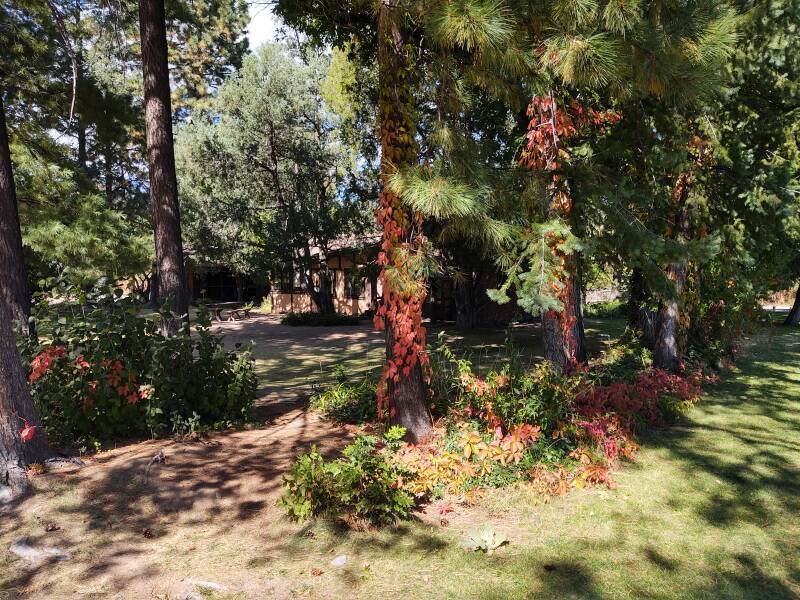

J. Robert Oppenheimer's Los Alamos ID badge.
Oppenheimer and Groves had very different personalities, but they worked together well. Groves had just left a project directing the construction of the Pentagon, the War Department's new headquarters across the river from Washington, D.C., the world's largest office building at the time.
Several years before, Oppenheimer had been diagnosed with a mild case of, yes, tuberculosis, and spent several weeks on a ranch in New Mexico, which he loved. The ranch became available for lease, and then purchase, and he bought it. He was familiar with the area, and could make specific recommendations to Groves about where to locate the research project. They had already decided that it should be isolated, but still with access to transportation and communication links. The rugged plateau on which the Los Alamos Ranch School stood along with the nearby city of Santa Fe fit their requirements.
Oppenheimer had left-wing political views, and his wife, girlfriend, brother, and brother's wife were openly members of Communist organizations. He had no background as a leader of large organizations. In all, he was not an obvious candidate for leading a gigantic but secret military project. However, he had broad knowledge and an excellent understanding of the practical aspects of the project. He quickly assembled a team of the top physicists and chemists. Then he became an admired and beloved leader of the project.
Here's the back corner of Oppenheimer's house.
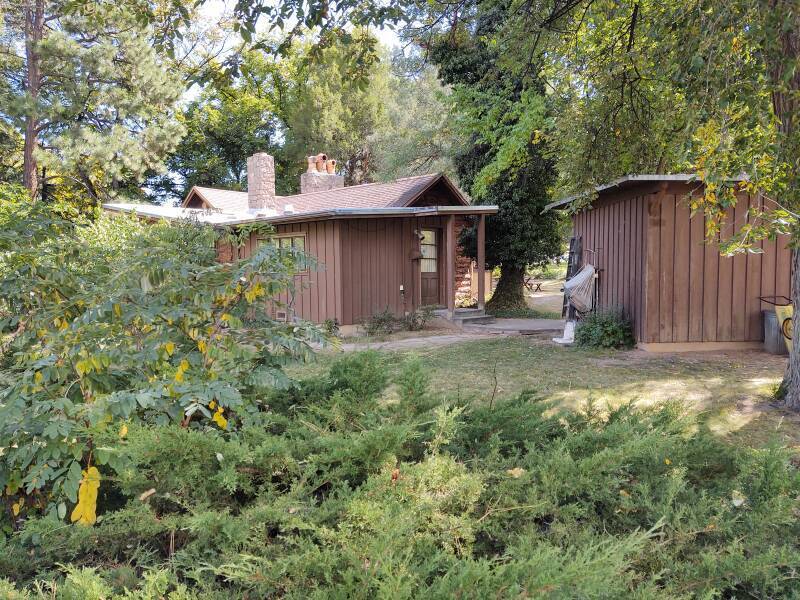
Bergen (known as Jerry) and Helene Suydam had moved into the home in 1956. Jerry was a theoretical physicist, and Helene had worked on determining artillery trajectories, testing proximity fuses, and developing the Norden bombsight. In 1969 the "company town" of Los Alamos was privatizing, and the Suydams bought the house. In 2003 they entered into a living trust agreement with the Los Alamos Historical Society, and continued living there. Jerry died in 2011, at the age of 95, and Helene died in 2020 at the age of 100.
These pictures are from my visit in October 2023. Renovation work was underway to open the house for visitors.
These architectural drawings are in the museum. The first shows the house's 1929 original construction and modification during 1943–1945 when the Oppenheimers lived there. It was built with an indoor bathroom in 1929, but notice how tiny it was. The Oppenheimers converted the kitchen into a dining room, converted the porch into a kitchen, and added a new small porch.

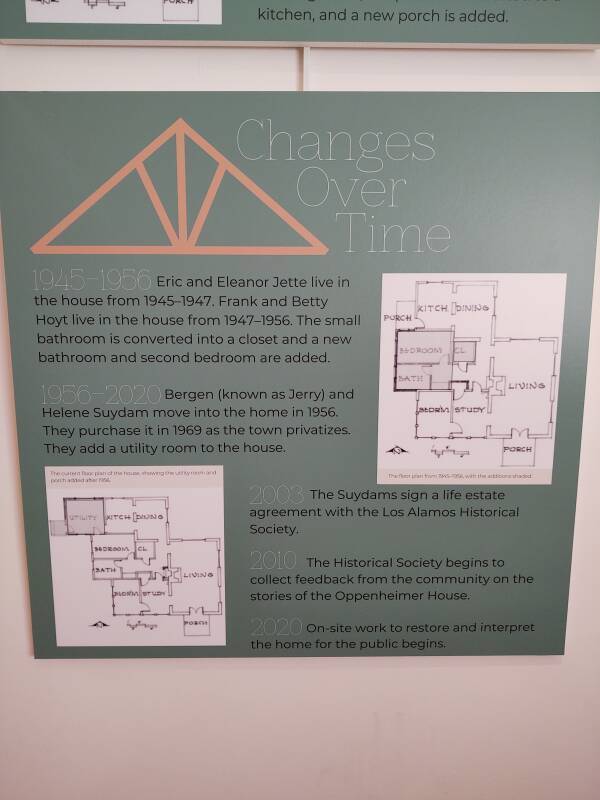
Oppenheimer left the project in October 1945, just a few months after two nuclear devices designed at Los Alamos were dropped on Hiroshima and Nagasaki, Japan.
After the Oppenheimers left in late 1945, a second bedroom and new, larger, bathroom were added. The original small bathroom became a closet!
The Suydams added a new utility room off the kitchen on the northwest side some time after 1956.
The below picture views the house from its southwest corner. Compare the picture to the last plan above. The room at the near corner with the yellow exterior walls and many windows, was the original bedroom. The bathroom that the Suydams added is in the nearest corner of the section with log exterior, its window is visible to the left of the exterior corner. The utility room is further to the left.

In 1947 J. Robert Oppenheimer became the directory of the Institute for Advanced Study in Princeton, New Jersey.
The Los Alamos town and the adjacent Laboratory were transferred from the U.S. Army to the Atomic Energy Commission in 1947. However, Los Alamos remained a closed city for another ten years. In 1957 the outer gate and guard towers were retired. Los Alamos County purchased the Fuller Lodge and some other structures.
Continuing Toward Valles Caldera
NM 502 continues through the town of Los Alamos, ending as it tees into NM 501. You can continue on that for a short distance to the security gate of LANL. That's the secure perimeter of one of the two nuclear weapons design laboratories in the U.S., so it's intentionally rather intimidating. Show your ID to the guard and continue for a short distance across the northwest corner of the laboratory and out through another gate, and continue on NM 501 to cross the northwest corner of LANL.
On that road you pass the Strategic Computing Complex housing LANL's supercomputing center. They have been naming their Linux supercomputers after significant early test shots, Trinity was the top machine when I passed through in late 2023 but Crossroads had just been assembled and was being tested.
ENIAC was the first programmable, general purpose computer. It had been designed to calculate artillery firing tables, but it was first put to work in December 1945 to do the calculations Los Alamos scientists needed to determine the feasibility of the "Super" design, the first thermonuclear device. It was electronic, but at the time that meant octal-base vacuum tubes and crystal diodes in addition to many relays. There were ten dual triodes for each flip-flop circuit.
ENIAC was programmed by plugboard wiring and three function table panels with 1,200 ten-way switches each. It cranked along at 500 floating-point operations per second, much faster than the previous electromechanical systems. Trinity runs at a maximum of 40 petaflops, about 80,000,000,000,000 times as fast, and Crossroads should be twice as fast.


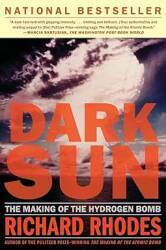
The Rio Grande, known as Rio Bravo in Mexico, is 3,051 km long, the fourth-longest river in (and along) the U.S. However, it is neither wide nor deep, especially in northern New Mexico!